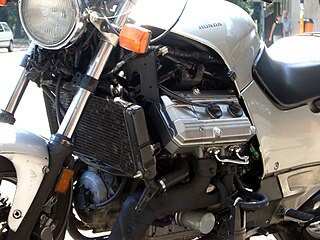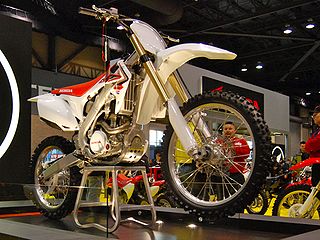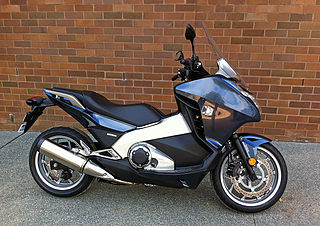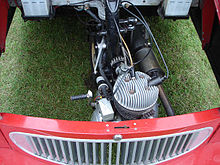
A reciprocating engine, also often known as a piston engine, is typically a heat engine that uses one or more reciprocating pistons to convert high temperature and high pressure into a rotating motion. This article describes the common features of all types. The main types are: the internal combustion engine, used extensively in motor vehicles; the steam engine, the mainstay of the Industrial Revolution; and the Stirling engine for niche applications. Internal combustion engines are further classified in two ways: either a spark-ignition (SI) engine, where the spark plug initiates the combustion; or a compression-ignition (CI) engine, where the air within the cylinder is compressed, thus heating it, so that the heated air ignites fuel that is injected then or earlier.

A V6 engine is a six-cylinder piston engine where the cylinders share a common crankshaft and are arranged in a V configuration.

A V4 engine is a four-cylinder piston engine where the cylinders share a common crankshaft and are arranged in a V configuration.

A flat-twin engine is a two-cylinder internal combustion engine with the cylinders on opposite sides of the crankshaft. The most common type of flat-twin engine is the boxer-twin engine, where both pistons move inwards and outwards at the same time.

A flat-four engine, also known as a horizontally opposed-four engine or boxer engine, is a four-cylinder piston engine with two banks of cylinders lying on opposite sides of a common crankshaft. The most common type of flat-four engine is the boxer-four engine, each pair of opposed pistons moves inwards and outwards at the same time.

A straight-twin engine, also known as an inline-twin, vertical-twin, or parallel-twin, is a two-cylinder piston engine whose cylinders are arranged in a line along a common crankshaft.

A straight-four engine is a four-cylinder piston engine where cylinders are arranged in a line along a common crankshaft.

A straight-three engine is a three-cylinder piston engine where cylinders are arranged in a line along a common crankshaft.

A motorcycle engine is an engine that powers a motorcycle. Motorcycle engines are typically two-stroke or four-stroke internal combustion engines, but other engine types, such as Wankels and electric motors, have been used.

The Honda CRF series is a line of four-stroke motocross, trail, and dual sport motorcycles manufactured and marketed by Honda.

Villiers Engineering was a manufacturer of motorcycles and cycle parts, and an engineering company based in Villiers Street, Wolverhampton, England.

The Harley-Davidson Twin Cam are motorcycle engines made by Harley-Davidson from 1998 to 2017. Although these engines differed significantly from the Evolution engine, which in turn was derived from the series of single camshaft, overhead valve motors that were first released in 1936, they share a number of characteristics with nearly all previous Harley-Davidson engines. Both engines have two cylinders in a V-twin configuration at 45°, are air-cooled, and activate valves with push-rods. The crankshafts have a single pin with a knife and fork arrangement for the connecting rods. These are sandwiched between a pair of flywheels.

The Yamaha WR450F is an off-road motorcycle made by Yamaha Motor Company. It currently has a 450 cc (27 cu in) liquid-cooled single-cylinder engine. First offered in 1998 at 400cc, it shared many components and design concepts with the YZ400F motocross model. It is basically the racing YZ450F detuned slightly for more controllable power, with a headlight and lighting coil, softer suspension, a kickstand, lower noise specifications, larger radiators and lower emissions. The WR in the name indicates a wide-ratio gear box common to most enduro or trail bikes and stands in contrast to the close-ratio gearbox essential to a motocross racer. Over the years the WR has benefited from the advances made in the YZ motocross version gaining displacement and advancements such as an aluminum frame and improved suspension. Over much of its life the weight of the WR450F has remained fairly constant ranging from 244 to 249 pounds dry weight.
Motorcycle components and systems for a motorcycle are engineered, manufactured, and assembled in order to produce motorcycle models with the desired performance, aesthetics, and cost. The key components of modern motorcycles are presented below.

The Ducati Supermono is a lightweight, single-cylinder racing motorcycle made by Ducati and named after the Supermono racing class. 65 Supermonos were built by Ducati between 1993 and 1995.

In internal combustion engines, a split-single design is a type of two-stroke where two cylinders share a single combustion chamber.

A scooter is a motorcycle with an underbone or step-through frame, a seat, a transmission that shifts without the operator having to operate a clutch lever, a platform for the rider's feet, and with a method of operation that emphasizes comfort and fuel economy. Elements of scooter design were present in some of the earliest motorcycles, and motor scooters have been made since at least 1914. More recently, scooters have evolved to include scooters exceeding 250cc classified as Maxi-scooters.

The Honda NC700D/NC750D Integra is a motorcycle/scooter hybrid made by Honda since 2012. Known internally as the RC62, the Integra was originally unveiled as the New Mid Concept in 2010, before being presented in production form at EICMA 2011 in Milan. The Integra shares a platform with two motorcycle variants, the NC700S (RC61) and the NC700X (RC63). All three variants are powered by a 670 cc engine derived from the unit used in the Honda Fit automobile. The Integra will be available with two different power outputs, one version develops a peak power output of 38.1 kW (51.1 hp) at 6,250 rpm and 62 N⋅m (46 lb⋅ft) of torque at 4,750 rpm, while the other has a lower output of 35 kW (47 hp) and 60 N⋅m (44 lb⋅ft) to meet 2013 A2 European licensing regulations.

The Suzuki A100 is a Japanese motorcycle from the Suzuki Motor Corporation with production starting in 1966.Similar models were produced by Yamaha and Kawasaki with the YB100 & KH100 models, also with a single-cylinder two-stroke engine and rotary valve being examples.
The Ducati 100 Scrambler is an on/off road 98 cc (6.0 cu in) single cylinder two stroke motorcycle produced by the Italian manufacturer Ducati in 1970 and 1971. The model was produced to take advantage of the dirt bike craze in Italy at the time. The model used many parts from existing models, keeping R&D costs down. A smaller engined version, the 50 Scrambler, was also produced. The model did not sell well and was soon dropped.




















